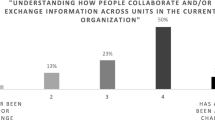Abstract
The problem of organizational structure formation is considered as a problem of discrete optimization, i.e., the search for an admissible hierarchy minimizing total costs on the maintenance of its managers. The problem is solved for the case of so-called homogeneous manager cost functions. It was proved that each manager of the optimal hierarchy has an approximately equal number of immediate subordinates and divides the department subordinate to him among them in a roughly identical proportion. Is deduced an analytic formula of the lower estimate of the optimal hierarchy cost that has many fields of application and in the majority of cases allows constructing suboptimal organizational hierarchies.
Similar content being viewed by others
References
Filosofskii entsiklopedicheskii slovar’ (Philosophical Encyclopaedia), Moscow: Sovetskaya Entsiklopediya, 1983.
Tsvirkun, A.D., Osnovy sinteza struktury slozhnykh sistem (Synthesis of the Structure of Complex Systems), Moscow: Nauka, 1982.
Huffman, D.A., A Method for the Construction of Minimum-Redundancy Codes, Proc. IRE, 1952, no. 9, pp. 1098–1101.
Radner, R., Hierarchy: The Economics of Managing, J. Econom. Literatur., 1992, vol. 30, no. 3, pp. 1382–1415.
Mintzberg, H., The Structurung of Organizations, Englewood Cliffs: Prentice Hall, 1979. Translated under the title Struktura v kulake: sozdanie effektivnoi organizatsii, Moscow: Piter, 2001.
Ovsievich, B.I., Modeli formirovaniya organizatsionnykh struktur (Models of Formation of Organizational Structures), Leningrad: Nauka, 1979.
Voronin, A.A. and Mishin, S.P., Modelling the Structure of an Organizational System. On the Algorithms to Seek the Optimal Tree, Vestn. VolGU, Ser. 1, Mat. Fiz., 2001, pp. 78–98.
Voronin, A.A. and Mishin, S.P., Optimal’nye ierarkhicheskie struktury (Optimal Hierarchical Structures), Moscow: Inst. Probl. Upravlen., 2003.
Mishin, S.P., Optimal’nye ierarkhii upravleniya v ekonomischeskikh sistemakh (Optimal Control Hierarchies in Economic Systems), Moscow: PMSOFT, 2004.
Mishin, S.P., Optimality of Tree Hierarchy of Symmetric Production Line Control, Probl. Upravlen., 2006, no. 6, pp. 36–42.
Burkov, V.N., Zalozhnev, A.Yu., and Novikov, D.A., Teoriya grafov v upravlenii organizatsionnymi sistemami (Graph Theory in Controlling Organizational Systems), Moscow: Sinteg, 2001.
Beckmann, M.J., Some Aspects of Returns to Scale in Business Administration, Quarterly J. Econom., 1960, vol. 74, no. 3, pp. 464–471.
Bolton, P. and Dewatripont, M., The Firm as a Communication Network, Quarterly J. Econom., 1994, vol. 109, no. 4, pp. 809–839.
Calvo, G.A. and Wellisz, S., Supervision, Loss of Control and the Optimal Size of the Firm, J. Political Econom., 1978, vol. 86, no. 5, pp. 943–952.
Geanakoplos, J. and Milgrom, P., A Theory of Hierarchies Based on Limited Managerial Attention, J. Japan. Int. Econom., 1991, vol. 5(3), pp. 205–225.
Radner, R., The Organization of Decentralized Information Processing, Econometrica, 1993, vol. 61, no. 5, pp. 1109–1146.
Van Zandt, T., Hierarchical Computation of the Resource Allocation Problem, Princeton: Princeton Univ. Press, 1994.
Williamson, O., Hierarchical Control and Optimal Firm Size, J. Political Econom., 1967, vol. 75, no. 2, pp. 123–138.
Vlasyuk, B.A. and Morosanov, I.S., Synthesis of the Hierarchical Control Structure in Large Systems, Avtom. Telemekh., 1973, no. 3, pp. 110–120.
Gubko, M.V., Matematicheskie modeli optimizatsii ierarkhicheskikh struktur (Mathematical Models of Hierarchical Structures Optimization), Moscow: LENAND, 2006.
Roberts, D.R., A General Theory of Executives Compensation Based on Statistically Tested Propositions, Quarterly J. Econom., 1956, vol. 70, no. 2, pp. 270–294.
Zhou, X., CEO Pay, Firm Size, and Corporate Performance: Evidence from Canada, Canadian J. Econom., 2000, vol. 33, no. 1, pp. 213–251.
Baker, J.P., Jansen, M.C., and Murphy, K.J., Compensation and Incentives: Practice and Theory, J. Finance, 1988, vol. 43, pp. 593–616.
Ciscel, D.H. and Carroll, D.M., The Determinants of Executive Salaries: An Econometric Survey, Rev. Econom. Statist., 1980, vol. 62, pp. 7–13.
Kostiuk, P.F., Firm Size and Executive Compensation, J. Human Resources, 1989, vol. 25, pp. 91–105.
Davis, H.T., The Theory of Econometrics, Bloomington: Principia, 1941.
Keren, M. and Levhari, D., The Internal Organization of the Firm and the Shape of Average Costs, Bell J. Econom., 1983, vol. 14, no. 2, pp. 474–486.
Qian, Y., Incentives and Loss of Control in an Optimal Hierarchy, Rev. Econom. Studies, 1994, vol. 61, no. 3, pp. 527–544.
Aghion, Ph. and Tirole, J., Formal and Real Authority in Organizations, J. Political Econom., 1997, vol. 105, no. 1, pp. 1–29.
Gubko, M.V. and Karavaev, A.P., Coordination of Interests in the Matrix Control Structures, Avtom. Telemekh., 2001, no. 10, pp. 132–146.
Kolmogorov, A.N. and Fomin, S.V., Elementy teorii funktsii i funktsional’nogo analiza (Elements of the Theory of Functions and Functional Analysis), Moscow: Fizmatlit, 2004.
Gubko, M.V., Structure of the Optimal Organization of a Continuum of Executives, Avtom. Telemekh., 2002, no. 12, pp. 116–130.
Hardy, G.H., Littlewood, J.E., and Polya, G., Inequalities, London: Cambridge Univ. Press, 1934.
Author information
Authors and Affiliations
Additional information
Original Russian Text © M.V. Gubko, 2008, published in Avtomatika i Telemekhanika, 2008, No. 1, pp. 97–113.
This work was supported by Academician Fedorenko International Scientific Foundation of Economic Research and the Russian Foundation for Basic Research, project no. 07-07-00078-a.
Rights and permissions
About this article
Cite this article
Gubko, M.V. The search for optimal organizational hierarchies with homogeneous manager cost functions. Autom Remote Control 69, 89–104 (2008). https://doi.org/10.1134/S0005117908010098
Received:
Published:
Issue Date:
DOI: https://doi.org/10.1134/S0005117908010098




